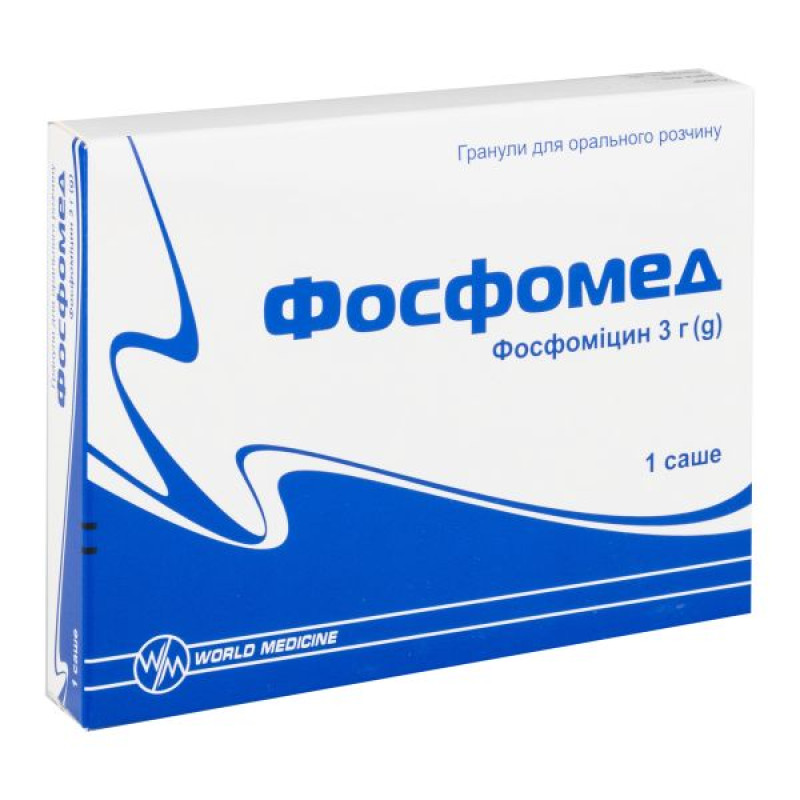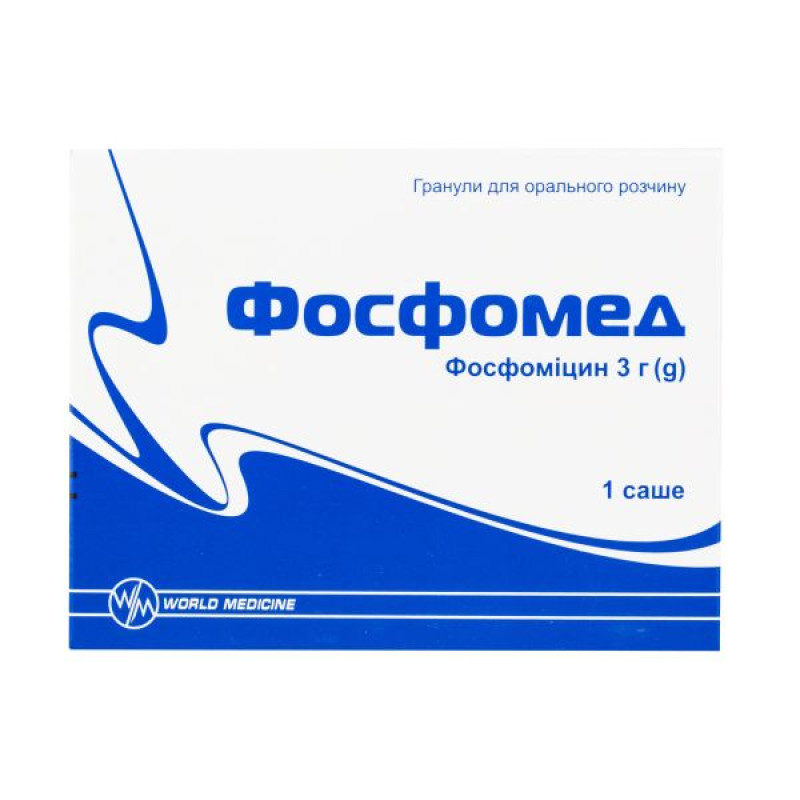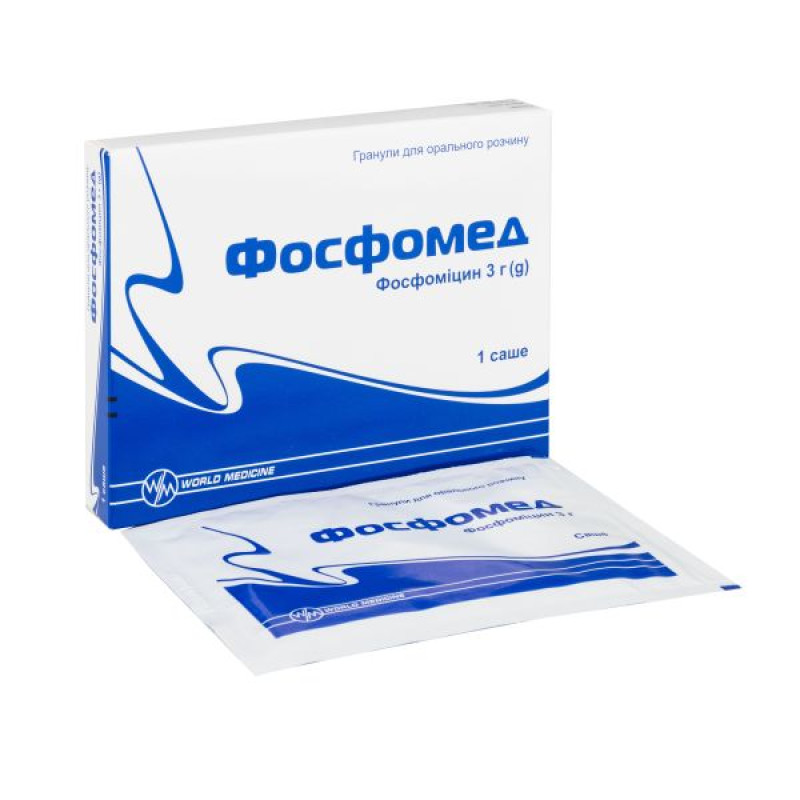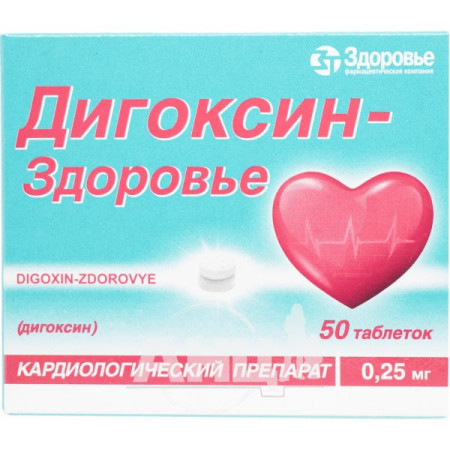Phosphomed granules for oral solution 3 g sachet No. 1

Pharmacological properties
Pharmacodynamics. Fosfomycin is a broad-spectrum antibiotic. The mechanism of its action is to inhibit the synthesis of the bacterial cell wall by inactivating phosphoenolpyruvate transferase, which leads to irreversible inhibition of the condensation of n-acetylglucosamine with phosphoenolpyruvate. Fosfomycin also reduces the co-aggregation of bacteria, which is a factor in the development of infections, and is characterized by the absence of cross-resistance with other antibiotics. It also has an anti-adhesive effect on bacteria that have the property of adhesion to the epithelium lining the urinary tract.
It is effective against the most frequently isolated strains of urinary tract infections: Citrobacter spp., Escherichia coli, Klebsiella oxytoca, Proteusmirabilis, Staphylococcus aureus - even if they are resistant to other antibacterial drugs. It is also active against Enterococcus faecalis, Enterobacter clo acae, Pseudomonas aeruginosa, Serratia marcescens, but resistance may develop. Bacteroides spp. is resistant to fosfomycin.
Pharmacokinetics. Fosfomycin is readily absorbed from the gastrointestinal tract. Absolute bioavailability after a single dose is 34-41%. Simultaneous food intake reduces the extent and rate of absorption. C max in blood plasma is observed after 2 hours and is 30-35 μg/ml. Does not bind to plasma proteins. Penetrates into body tissues, including the kidneys and bladder. Accumulates mainly in the kidneys at a concentration of 2500-3500 μg/ml (MIC for E. coli is 128 μg/ml). Does not penetrate the placental barrier. T ½ from blood plasma is about 4 hours.
Fosfomycin is not metabolized in the body, but is excreted by glomerular filtration into biologically active forms. Therapeutic concentrations in urine are usually maintained for up to 48 hours, which is sufficient for urine sterilization and recovery.
Special patient categories. In patients with impaired renal function, T½ increases in proportion to the degree of impairment. In the elderly, fosfomycin clearance decreases in accordance with age-related changes in renal function.
Indication
Treatment of acute uncomplicated lower urinary tract infections caused by microorganisms sensitive to fosfomycin in adults and girls aged 12 years and older; prevention of urinary tract infections during diagnostic procedures and surgical interventions in adults.Application
The drug is taken orally on an empty stomach (2-3 hours before or 2-3 hours after a meal), preferably before bedtime, after emptying the bladder. Dissolve the contents of the sachet in a glass of water and drink immediately.
Treatment of acute uncomplicated lower urinary tract infections. The usual single dose for adults and girls aged 12 years and over in the acute phase of the disease is 1 sachet (3 g) once.
Prevention of urinary tract infections during diagnostic procedures and surgical interventions. The drug should be used in a dose of 1 sachet (3 g) 3 hours before the intervention and again 1 sachet (3 g) 24 hours after the intervention.
Children. Possible use for the treatment of acute uncomplicated lower urinary tract infections in girls aged 12 years and older.
There is insufficient data on the use of the drug for therapeutic purposes in boys aged 12 years and older, as well as sufficient data on the use of the drug for prophylactic purposes in both boys and girls.
Contraindication
Hypersensitivity to the active substance or other components of the drug; use in patients with severe renal failure (creatinine clearance 10 ml/min); use in patients on hemodialysis; children under 12 years of age.Side effects
The most common adverse reactions with a single dose of fosfomycin include gastrointestinal disturbances, mainly diarrhea. These phenomena are most often short-lived and resolve on their own.
The frequency of side effects is determined as follows: very common (1/10); common (1/100-1/10); uncommon (1/1000-1/100); rare (1/10,000-1/1000); very rare (1/100,000); unknown (cannot be determined from the available data).
Within each frequency grouping, adverse reactions are presented in order of decreasing seriousness.
Adverse reactions and their frequency of development
| Infections and infestations | vulvovaginitis | |||
| On the part of the immune system | Anaphylactic shock, hypersensitivity reactions | |||
| From the nervous system | Headache, dizziness | paresthesia | ||
| From the side cardiovascular system | Tahikar-Diya | arterial hypotension | ||
| Respiratory, thoracic and mediastinal disorders | BA | |||
| From the digestive system | Diarrhea, nausea, upset stomach digestion | Abdominal pain, vomiting | pseudomembranous colitis | |
| Skin and subcutaneous tissue disorders | Rash, hives, itching | angioedema | ||
| Systemic disorders | fatigue | |||
Special instructions
When using broad-spectrum antibiotics, including fosfomycin, the development of antibiotic-associated colitis (including pseudomembranous colitis) is possible. The possibility of this diagnosis should be considered in patients who develop severe diarrhea during or after taking fosfomycin trometamol. If the diagnosis is confirmed, appropriate treatment should be initiated immediately. In this case, drugs that inhibit peristalsis are contraindicated.
Effective fosfomycin concentrations in urine persist for up to 48 hours at a creatinine clearance of 10 mL/min.
The product contains sucrose. Patients with fructose intolerance, glucose-galactose malabsorption syndrome or sucrase-isomaltase deficiency should not take this medicine.
Use during pregnancy or breastfeeding
Pregnancy. According to available data, fosfomycin does not have a teratogenic / fetotoxic effect. During pregnancy, the use of the drug is possible if necessary, when the expected benefit to the woman outweighs the potential risk to the fetus.
There are no reviews for this product.
There are no reviews for this product, be the first to leave your review.
No questions about this product, be the first and ask your question.











